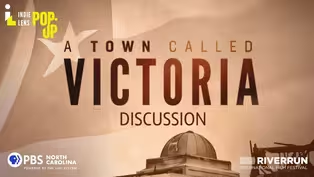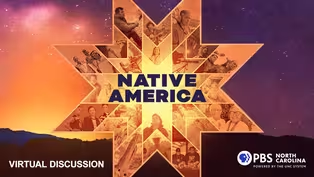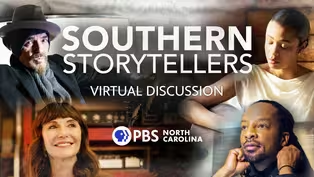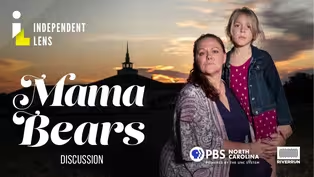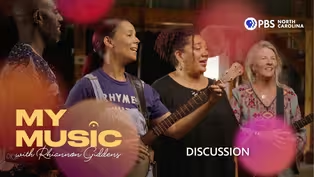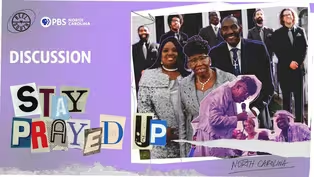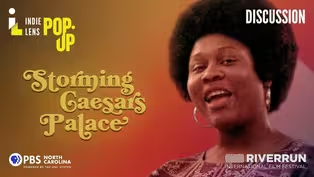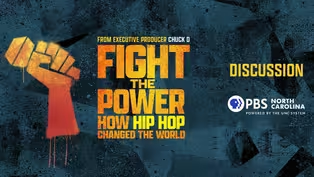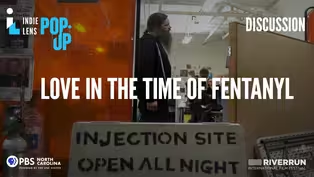PBS North Carolina Specials
Discussion - State of Change: Living with Water
4/22/2025 | 28m 54sVideo has Closed Captions
Panelists discuss resilient North Carolinians adapting to climate change.
Michelle Lotker, producer, State of Change: Living with Water, leads a discussion on North Carolina's climate resiliency. Panelists: Kathie Dello, State Climatologist; Ryan Emanuel, Ph.D., Associate Professor, Duke University, Citizen of the Lumbee Tribe; Rose Jenkins Lane, Conserving Carolina; Terry DeMeo, Living with Water Project Manager, USS North Carolina Battleship Memorial
Problems playing video? | Closed Captioning Feedback
Problems playing video? | Closed Captioning Feedback
PBS North Carolina Specials is a local public television program presented by PBS NC
PBS North Carolina Specials
Discussion - State of Change: Living with Water
4/22/2025 | 28m 54sVideo has Closed Captions
Michelle Lotker, producer, State of Change: Living with Water, leads a discussion on North Carolina's climate resiliency. Panelists: Kathie Dello, State Climatologist; Ryan Emanuel, Ph.D., Associate Professor, Duke University, Citizen of the Lumbee Tribe; Rose Jenkins Lane, Conserving Carolina; Terry DeMeo, Living with Water Project Manager, USS North Carolina Battleship Memorial
Problems playing video? | Closed Captioning Feedback
How to Watch PBS North Carolina Specials
PBS North Carolina Specials is available to stream on pbs.org and the free PBS App, available on iPhone, Apple TV, Android TV, Android smartphones, Amazon Fire TV, Amazon Fire Tablet, Roku, Samsung Smart TV, and Vizio.
Providing Support for PBS.org
Learn Moreabout PBS online sponsorshipMore from This Collection
Recordings of previous virtual event discussions.
Discussion - A Town Called Victoria - Independent Lens
Video has Closed Captions
The filmmaker and former Victoria residents share their story. (46m 51s)
Discussion - Native America Season 2
Video has Closed Captions
Panelists discuss preserving the languages of Native American tribes. (39m 1s)
Video has Closed Captions
Sci NC executive producer and host, Frank Graff, chats about upcoming Season 6 of Sci NC. (26m 6s)
Discussion - Southern Storytellers
Video has Closed Captions
Author David Joy and others discuss storytelling and their new PBS series. (42m 13s)
Discussion - Mama Bears | Independent Lens
Video has Closed Captions
Producer and director Daresha Kyi discusses the film and LGBTQIA+ advocacy. (34m 41s)
Discussion - My Music with Rhiannon Giddens
Video has Closed Captions
Discussing the series with producers Will & Deni McIntyre and country artist Rissi Palmer. (39m 56s)
Discussion - Free Chol Soo Lee | Independent Lens
Video has Closed Captions
Local lawyers, professors and nonprofit leaders discuss wrongful convictions and reentry. (40m 44s)
Discussion - Stay Prayed Up, Reel South
Video has Closed Captions
The filmmakers discuss their journey with Mother Perry and The Branchettes. (45m 4s)
Discussion - Storming Caesars Palace | Independent Lens
Video has Closed Captions
Local professors and nonprofit leaders discuss welfare and the social safety net. (33m 2s)
Discussion - Fight the Power: How Hip Hop Changed the World
Video has Closed Captions
Local experts discuss the history of hip hop with PBS North Carolina. (59m 43s)
Discussion - Love in the Time of Fentanyl | Independent Lens
Video has Closed Captions
Local harm reductionists, therapists and others discuss the opioid crisis and more. (55m 44s)
Discussion | Independent Lens: Move Me
Video has Closed Captions
A dancer with blindness and disability advocates discuss adaptable arts programs. (38m 46s)
Providing Support for PBS.org
Learn Moreabout PBS online sponsorship- Thank you again everyone for being here tonight.
As you already know, I'm Michelle Lotker, the producer of this special that we just watched.
And the awesome panel we have here today, you'll recognize some familiar faces, but I will go ahead and introduce everyone again.
I will start with Kathie Dello, North Carolina's state climatologist.
She's been with us for a few of these specials now.
I'm just grateful to have her here for her insights on climate change impacts across the state as a whole.
We have Ryan Emanuel, hydrologist at Duke University, citizen of the Lumbee tribe.
Recently published a book called "On the Swamp" and that's part of how I found this story that you saw here today with the Coharie River Initiative.
Rose Lane, communications director at Conserving Carolina.
And, as you saw, based in Henderson County, doing a lot of work even beyond what you saw tonight.
So be sure to check them out online.
They do lots of great communication on social media.
And I know your name, but I want to remember what I'm going to say about you.
Terry Demeo, development director at the battleship North Carolina Monument in Wilmington, where you can visit the ship and you can see their "Living with Water" project, although I did borrow that title because it was too perfect a fit for the storytelling.
And you can see both the ship and all of that environmental work in progress.
All right.
So I will kick things off, but we really do want to hear from all of you.
So please start thinking of questions.
And we will have someone in each aisle with a microphone, I believe.
And so please just put your hand up and they will come to you with the mic.
And I will make sure I'm going to keep an eye out to try to spot you as well.
We also have some people joining us virtually online, and we're so glad you're here as well.
So please, we have someone monitoring the chat.
So put your questions in there.
We want to hear from you.
And, of course, we want to hear from as many people as possible.
So try to keep it short and sweet with your questions so we can hear from our panelists.
Okay.
So I'll kick things off.
I got a question for each of you.
And we'll see what else the audience wants to know.
So we'll start with you, Kathie.
Can you paint a picture for us of what's going on with climate change in North Carolina right now, more broadly, water-related or not?
You wanted me to keep it brief.
One, it's great to see everyone.
I know the Canes are playing right now.
So thank you for showing up.
But I did this last year after the screening, and I thought back to last April and what had happened since then.
Massive flash drought in June, which killed a pretty significant part of North Carolina's corn crop.
The hottest temperature on record at Raleigh-Durham Airport.
Hurricane Helene.
Potential tropical cyclone 8, which dropped 20 inches of rain out Terry's Way, which was almost forgotten about because it happened two weeks before Helene.
And if I had sat here in April and said, "Western North Carolina is actually going to get decimated by a hurricane.
We're going to have a flash drought that kills the corn crop, and it's going to be 106 degrees the day after July 4th," I would have felt like I was just offering a picture of doom and gloom.
It all happened.
And it's happening.
And we're living with it.
And as Ryan said in the documentary, we can't stop these storms from happening.
I am looking at hurricane season.
I'm always looking at hurricane season.
I go to hurricanes.gov every single morning during hurricane season.
And early forecasts are saying that it's going to be another big hurricane season.
The ocean temperatures are warm, and the winds aren't really doing anything positive or negative for us.
But we know in North Carolina it only takes one.
It takes a Florence.
It takes a Matthew.
It takes a Helene.
I'm looking at warming temperatures.
I'm looking at the drought we had after Helene and the wildfires they had in Western North Carolina due to the tree fall.
I've got my eyes kind of on all of it and also know that it was 90 degrees a couple weeks ago here in Raleigh.
So climate change is here and now.
That being said, I do want to end on this, a little bit of a positive note, in that we saw a lot of stories about resilience and people living with water and living with climate change.
I want to say one of the most heartening things after Helene in talking with people is just how North Carolinians came together to help each other out.
While we're thinking about all those terrible things, and if I come back next year and tell you more terrible things, just remember we're all in this together.
Thanks, Kathie.
Yes, we're certainly not trying to bury our heads in the sand.
I think the urgency behind all this work comes from all of us as a state and world.
So interacting with their environments in positive ways, indigenous people have been doing that for the whole time they've been on this planet.
Can you talk to me a little bit about one of the things we hear a lot is the "un-native."
How can you disrupt that sort of myth?
Just talking about how acknowledging that long knowledge indigenous communities have could help us in this work we're trying to do to combat climate change.
Thank you for letting me come here this evening.
I'm especially grateful to the Coharie folks, to Cullen and Greg and Philip, for allowing me to come and share a little bit about their story.
I'm glad you used that term "myth."
It's a pervasive myth that many of us were taught in school, myself included, that before settlers came, this was an untouched wilderness.
That's not true.
We know that indigenous peoples have lived in North Carolina for more than 10,000 years.
For much of that time, we were managing the landscape for purposes that benefit our own flourishing.
In particular, fire was a critically important tool to maintaining the types of forests and savannas that brought us rain, medicines, things like that.
There's this long history of indigenous peoples having a very hands-on active role in the management of their environments and the creation of these places that settlers arrived at and thought were these beautiful untouched wildernesses, but were really the result of careful management by indigenous peoples.
Awesome.
Thanks, Ryan.
There we go.
I'll ask you a little bit for a minute, but again with a hopeful piece to it.
I know Hurricane Helene should still be the impact that that storm had.
I'm curious, y'all were doing this restoration work before the storm.
How did the storm change?
Are you experiencing increased interest and support for that work?
How did the storm change what y'all are working on?
Like he said, we have been doing it since well before.
We had a tremendous increase in landowner interest after we were able to show the first example.
We had a lot of momentum already among landowners, but I think what has changed somewhat after the storm is that the work we're doing resonates a lot more with the public and it's found a broader audience.
I think the people who knew about it before already were pretty excited because even if you're not really interested in flood control, it's amazing for wildlife.
It's this incredible resurgence of life.
It's a really cool story and a lot of people already really love the river.
Then to have this other dimension about how just three of those places stored 1.25 billion gallons of water during Helene really makes the case that having these places gives us a safer and more resilient landscape.
I think on the public side, we are seeing a lot more interest.
Among landowners, we are seeing continued interest and also we're getting a lot of people reach out to us about a different problem, which is asking if we can help them restore stream banks that were wrecked during the storm or the aftermath of the storm, including some of the recovery activity to remove debris.
We're getting a different kind of interest from landowners, a lot of interest from the public.
We're also hoping that the fact that we can now show how impactful this is in terms of flood control will help us to make that case to the state because state funding really made it possible for us to do all of the projects that we've talked about.
We're really grateful to the state that they have the foresight to do this.
It's definitely part of the thinking.
It isn't interest.
It's not interest.
It's really funding.
Hopefully, this will help make the case to everybody involved that we need to do more of it.
-The documentation of the volume of water held at those sites was very impactful, benefit even more.
Terri, when I was working on this story, I kept trying to think of how to flip Pave Paradise, put up a parking lot to get rid of the parking lot, put back the tidal wetland.
I don't know.
It didn't flow as well off the tongue.
I'm curious.
We heard about it a little bit.
Can you talk a little more about this choice to go the route of returning back to the natural state of that land prior to it being paved rather than built?
-I guess that the best way to describe the story is that in 2015, when we began to notice changes in the river, and the fact that the river was flooding much more frequently, the decision was made to go with this nature-based approach because the folks that were involved in that decision at the time had been accustomed to watching the river really over the course of their career.
Part of the success in any operation is understanding that your site conditions, where you are, where you need to be, what's happening, how to be successful in that circumstance.
Although we undertook some initial investigations of traditional approaches, the decision was made to go with this nature-based approach, feeling that it was a softer way to work with the landscape and had more opportunity for building resilience.
The conditions not only that we were seeing at that time, but that we were... -Thank you.
It's just such a theme of humans interacting with landscapes, observational learning, and looking towards the future and resilience.
I see some hands.
I think Frank is coming your way with the microphone.
We'll move around the room.
-Excuse me one second.
I'm most interested in the lady with the conservancy.
What did...doing the right things?
-Yeah, so we did see a really enormous amount of water was stored on those three sites that I was talking about.
It was over a billion gallons of water.
It just shows the sheer volume of water that can be held there.
However, it would also be fair to point out that that water was going to go onto the floodplain anyway.
If it had been houses there, it would have gone there and gone over and into and around the houses.
Or if it had been farm fields, it would have covered up the corn under 30 feet of water.
I think what you can see in those places is that they stored a phenomenal volume of water, and it was fine.
It didn't hurt anything.
The water was there for a time, and then it moved on, and the floodplains were fine.
It was there, and it was non-destructive.
Also, in a more typical flood, a more normal flood, you would have an even more impactful story because the fact that the river is bermed along most of its length, that means the water can't get out of the river until it's very high, so until it can get over these kind of eight-foot berms and reach the floodplain.
So because we've breached the berms, the water can flood much sooner at a lower elevation and get onto the floodplain.
So that means that water that's accessing the floodplain is not going downstream.
It's not flooding downstream.
So you would actually have an even more kind of greater flood benefit in kind of a more normal flood.
But in Helene, berms weren't going to keep the water out.
It was going to go there anyway.
Thanks.
We have someone over here.
Chris?
Hi.
So my question is, in my job currently, we're having some issues.
Climate is in my title.
Climate is what I do, and climate is what I'm going to continue doing.
That being said, we always work with people and meet them where they're at, and that may mean that we are spending an hour talking about the football game and getting to know them and their family and breaking bread together, and then we might start talking about flooding and drought and things that may be more approachable but also are more tangible.
Climate change is this big nebulous, scary thing, but we just saw so many examples of flooding and water and drought.
That being said, I mean, we're going to continue to do the work that we need to do, and North Carolina's doing the work, and I don't necessarily know what the future holds, but I know that our weather is getting more extreme, and I know the data shows it, and I'm sorry you're going through that at work and not giving you very concrete, tangible things you can take away, but hang in there.
Anybody else having experiences with funding things that they can talk about?
[laughter] It's obviously a very complicated situation and constantly evolving, and I think there's a lot of good work already in motion that is happening and underway, so that's really heartening, and one thing I know from talking to a lot of scientists in my job is that everyone's really creative and constantly problem-solving, so I'm hopeful that--it's a great question.
I'm sorry we don't have an easy answer, but I think that all the scientists and people doing this work, hopefully you included, continue to figure out how to get that awesome work done.
Thank you for the question.
We have someone on this side of the room, and then we'll go online next.
I see you.
Get an online-- Oh, sure.
Go ahead.
Okay, testing.
All right, so one question from our virtual audience.
In a changing climate environment and in the aftermath of Hurricane Helene's impact in western North Carolina, what new strategies have we learned to adapt in the coming years to avoid the disastrous flooding we faced last year?
So the question is, what new strategies have we learned to avoid that kind of flooding?
Well, I think that--I mean, I wish I knew a way that we could avoid that kind of flooding, but I think certainly having the floodplains there to absorb the floodwaters when it comes is important, but I think also conservation more generally is important because a landscape that is more natural, which in western North Carolina means having a lot of forested landscapes, is going to absorb more of that water.
It's going to take it in.
That water is going to get sucked up by tree roots.
It's going to become part of trees.
It's going to be held in the soil, and the more the landscape is kind of bare or hard, the more it's going to run off right away, go straight into the river, and it's instantly a flood.
So I think conserving natural landscapes, including but not limited to floodplains, is really key.
I would, to extend Rose's comments, I think that I would describe it not as eliminating impacts of our natural systems, but building resiliency to the impacts of our natural systems and whatever you can do in a variety of ways, managing hydrology, recreating wetlands, recreating floodplains, and for us specifically, we're very invested in conserving the wetlands that are surrounding the ships and are on Eagles Island, our immediate neighbors, because we know that the marsh is like a sponge for absorbing those high tides and major weather events that will affect us.
I will just cut in and say that the weather forecast was perfect for Helene.
September 26th, this will be the most catastrophic event that Western North Carolina has seen in modern times.
And now we've seen it.
It's really hard to think about the worst thing that you've never seen.
We've seen Helene, and it will happen again.
So being armed with that knowledge and that information, I think, is really, really powerful in how we can empower ourselves to protect the future generations or even the next few years from catastrophic flooding by either building back more resiliently in safer places.
There was a water treatment plant, I think, in Henderson County that built to the 500-year standard that did fairly well during Helene.
So just knowing that we can build in little bits of resilience now for a better tomorrow.
Anything about the coastal plain?
Yeah.
You know, I'm thinking back to the back-to-back storms several years ago, Matthew and Florence, and following Hurricane Matthew in 2016, a lot of the communities in eastern North Carolina, I won't say that they were prepped or primed for Hurricane Florence, but that traumatic experience from Matthew really taught people to think about who do you turn to, who you're relying on during these times of disaster.
And so I think it showed us how powerful and important these community connections, social institutions, the organizations that we rely on and depend on.
There was something about those two storms, Matthew and Florence, that really showed the power of those social connections in this whole enterprise of resilience.
Awesome.
Thanks.
Another one?
This is a follow-up to the question the gentleman asked earlier about the flood plain.
Not necessarily in the Habitat for Humanity neighborhood, but in some of the other flood plains, they are also right on the edge of neighborhoods.
We did think in some of those cases the flooding in those neighborhoods would have been worse had it not been for the flood plain.
I don't know that the Habitat for Humanity neighborhood got flooded.
I do know that Habitat for Humanity, like they had that tract of land, and the flood plain area that they worked with us on, that was a no-build zone because it was a flooding area.
So they used their land as efficiently as they could to put up as many houses for people to live in, and then they wanted to also create an asset for the community in the flood plain area.
Chris, thanks.
Thank each of you on the stage, and also thank each of you in the audience who are here to learn and to also contribute annually with all the organizations that are involved in the ecology in North Carolina.
This would be a perfect venue here at the Museum of Science.
There are a lot of organizations that are involved in all this work.
That would be definitely a massive and an impressive group to convene.
I know that there are lots of great conferences and ways that people are coming together around their specific areas of work.
Do you have any thoughts about if someone wanted to get involved, are there events or gatherings of people that you all know about that would be a good fit?
I was recently at the Land Trust Alliance Southeast Conference, which was held in Asheville, which meets some of those criteria.
Land trusts or conservation organizations have the Land Trust Alliance National Conference, but there's also one every year in the Southeast.
I'm not sure it really meets the need that you're describing, because I do think it's a place where professional conservationists get together and talk about what they do and how we can learn from each other.
There are people who go to that conference who are just interested, so it's a possibility.
I just want to say also, I think a lot of this work that's very powerful is community-rooted and community-based.
I think even starting at the level of finding where in your local community that work is happening and getting engaged that way is also a great option.
We have a lot of hands up.
Frank, we got one on this side, and then we'll get one from the middle and online.
Frank is pointing me towards online.
Hello, online.
We're so glad you're here.
What is your question?
Our next one from online is kind of a two-fold.
To what extent does the state consider sustainability initiatives in planning and development of things to reduce our continued contributions to global warming, and with that, especially within metropolitan areas, so Charlotte and Asheville, that do not have as many barriers as others?
How is sustainability considered in planning for future development?
Do you have any insight on that, Cathy?
I'll offer an example of something that I do know.
We work closely with North Carolina Department of Transportation.
They came to us after Hurricane Matthew and Florence and said, "These storms are getting bigger.
They're wetter.
They're lasting longer.
We're building infrastructure that needs to last for 50 to 100 years."
And the precipitation data is out of date.
We need to work with you to upgrade the data, get it to current times, and then think about the future."
So we have been working with them really closely.
We've created data sets with them, and they are implementing them in practice.
So they're building roads and bridges that can withstand your Helenes and your Florences.
That's one particular example.
And I think you see a number of things happening around communities and cities.
We're here in downtown Raleigh.
There are a lot of trees here.
If you have allergies, you've known that in March and April, and those are very deliberate to help cool down the city.
The city also has some really interesting initiatives to plant those trees in places that also flood often, so getting at that compound hazard of heat and flooding as well.
Like Michelle said, it's very community-driven.
Sometimes it's neighborhood-driven.
Sometimes it's state agency-driven like North Carolina Department of Transportation, but I don't have one good, solid answer of absolutely everything that's happening.
Do you know about development?
No?
Okay.
Let's see.
Frank's got one over there.
We've got some in the middle.
We'll hit next.
I wanted to ask a question more about the producing and storytelling aspect.
I had an interest.
I'm part Lumbee, Croatan Indian myself, so the historical aspect of how you, maybe Michelle, kind of like cross-tied that into-- I wanted to kind of figure out where that derived from maybe, if that was necessarily a portion of the essence that you kind of found along the way.
Was that something that you kind of developed and maybe partnered with Ryan as the project kind of went along?
How did that come together?
So specifically the Coharie story?
Right.
I thought that was a great historical aspect that is important to kind of mention, and I just wanted to understand maybe where that cross-tie came as a storyteller.
Sure.
Thanks for asking.
I do think in all the storytelling I do, I try to make it very people-centered, so I do a lot of science storytelling, which could be very technical or more data-driven, but I think it's so much more engaging to hear from the people that are in those stories.
So I did go into that story wanting to learn about the initiative, the Coharie River Initiative and the great work they were doing, but when you start talking to people, you start to learn their stories, and I think just interacting with Colin and Philip and Greg and hearing what it really meant to them to be stewarding the river and for Philip and Greg to see this next generation coming back in and reconnecting with the river where this disconnect had occurred.
There was no way that couldn't be part of the story, and I think with all these stories there's a human aspect, and that's what makes you as an audience, I hope, want to know more and engage with the issue.
So I think that's just always the way that I approach these stories, is who are the people that are involved in being impacted, and how can I tell their stories accurately?
So hopefully that answers that.
Hello.
I wanted to first, the North Carolina Environmental Summit, it was beautiful.
It was hosted and taken work and brought that into your own neighborhood or family or communities.
What has that looked like for you all?
Who wants to go first?
Ryan, you look excited.
Yeah, thank you for that, and thank you for plugging the NC to these of our communities.
But to share them in a way that our own is reflected in that work and not as a tome.
I mean, it is an act of research and scholarship, but it's written in a way that resonates and lands well with communities so that Lumbee people, Coharie people, other people that read these stories can, at a very minimum, not experiencing these challenges and isolationize that there's a broader network of communities.
That's a very empowering thing.
And so I'm going to go back into the community and share from my book with the people who helped to bring it into being.
Support for PBS provided by:
PBS North Carolina Specials is a local public television program presented by PBS NC
